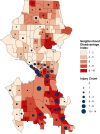Neighborhood disadvantage and firearm injury: does shooting location matter?
- PMID: 33678193
- PMCID: PMC7938602
- DOI: 10.1186/s40621-021-00304-2
Neighborhood disadvantage and firearm injury: does shooting location matter?
Abstract
Background: Firearm violence is a public health problem that disparately impacts areas of economic and social deprivation. Despite a growing literature on neighborhood characteristics and injury, few studies have examined the association between neighborhood disadvantage and fatal and nonfatal firearm assault using data on injury location. We conducted an ecological Bayesian spatial analysis examining neighborhood disadvantage as a social determinant of firearm injury in Seattle, Washington.
Methods: Neighborhood disadvantage was measured using the National Neighborhood Data Archive disadvantage index. The index includes proportion of female-headed households with children, proportion of households with public assistance income, proportion of people with income below poverty in the past 12 months, and proportion of the civilian labor force aged 16 and older that are unemployed at the census tract level. Firearm injury counts included individuals with a documented assault-related gunshot wound identified from medical records and supplemented with the Gun Violence Archive between March 20, 2016 and December 31, 2018. Available addresses were geocoded to identify their point locations and then aggregated to the census tract level. Besag-York-Mollie (BYM2) Bayesian Poisson models were fit to the data to estimate the association between the index of neighborhood disadvantage and firearm injury count with a population offset within each census tract.
Results: Neighborhood disadvantage was significantly associated with the count of firearm injury in both non-spatial and spatial models. For two census tracts that differed by 1 decile of neighborhood disadvantage, the number of firearm injuries was higher by 21.0% (95% credible interval: 10.5, 32.8%) in the group with higher neighborhood disadvantage. After accounting for spatial structure, there was still considerable residual spatial dependence with 53.3% (95% credible interval: 17.0, 87.3%) of the model variance being spatial. Additionally, we observed census tracts with higher disadvantage and lower count of firearm injury in communities with proximity to employment opportunities and targeted redevelopment, suggesting other contextual protective factors.
Conclusions: Even after adjusting for socioeconomic factors, firearm injury research should investigate spatial clustering as independence cannot be able to be assumed. Future research should continue to examine potential contextual and environmental neighborhood determinants that could impact firearm injuries in urban communities.
Keywords: Firearm violence; Injury epidemiology; Neighborhood disadvantage.
Conflict of interest statement
The authors declare that they have no competing interests.
Figures



References
-
- Baumer E, Horney J, Felson R, Lauritsen JL. Neighborhood disadvantage and the nature of violence. Criminology. 2003;41(1):39–72.
-
- Benns M, Ruther M, Nash N, Bozeman M, Harbrecht B, Miller K. The impact of historical racism on modern gun violence: Redlining in the city of Louisville, KY. Injury. Published online 2020. - PubMed
LinkOut - more resources
Full Text Sources
Other Literature Sources
Miscellaneous

